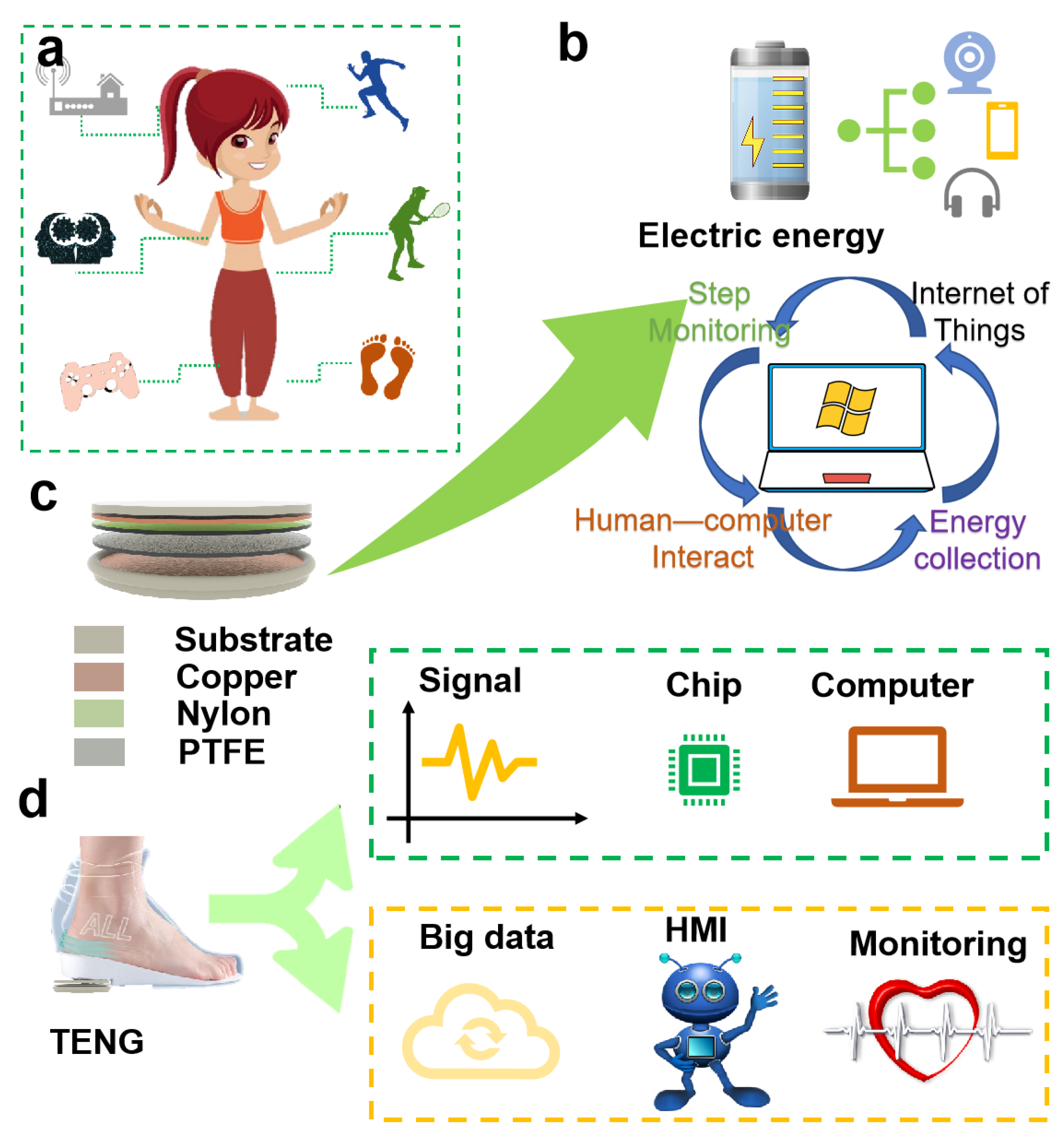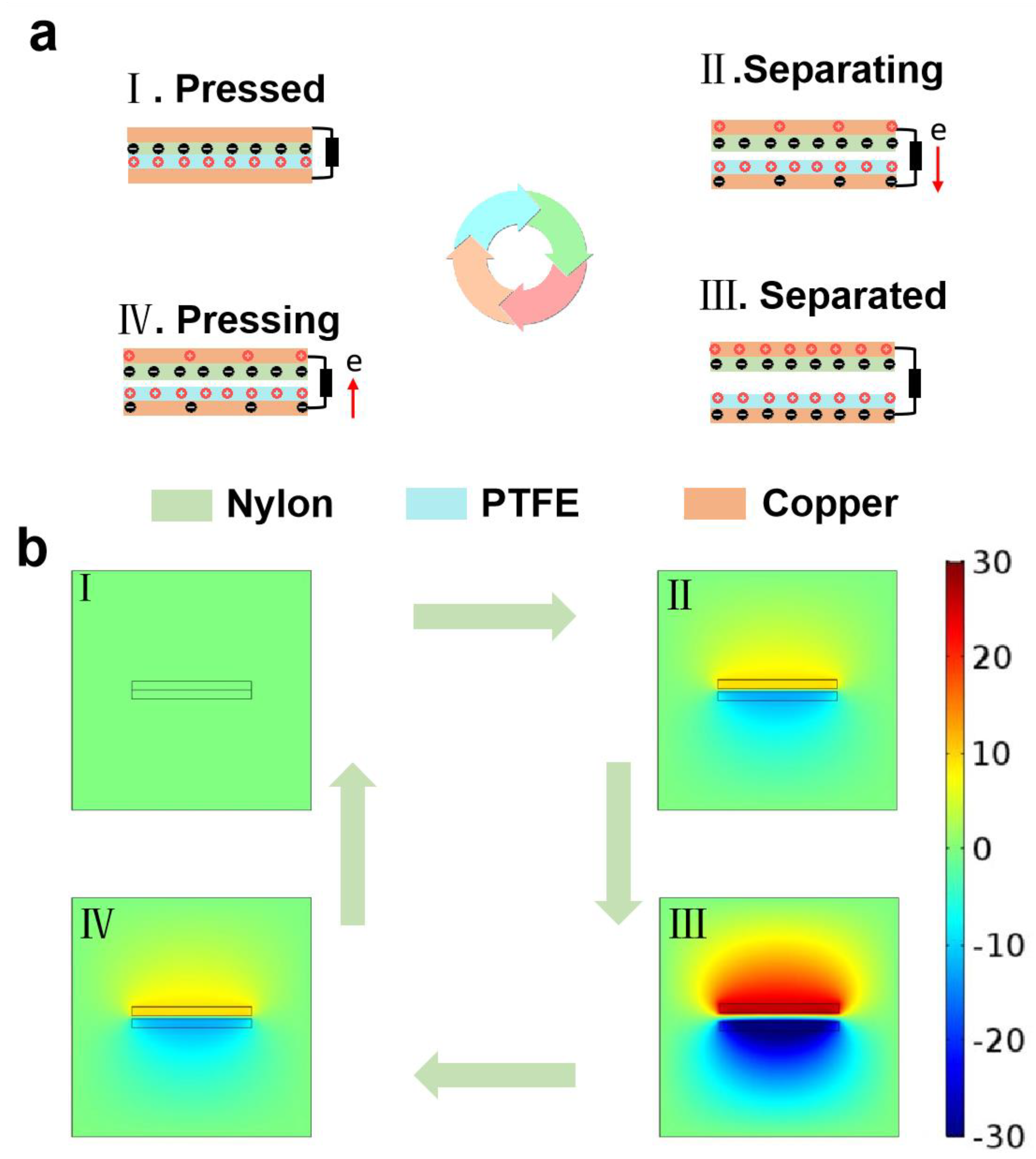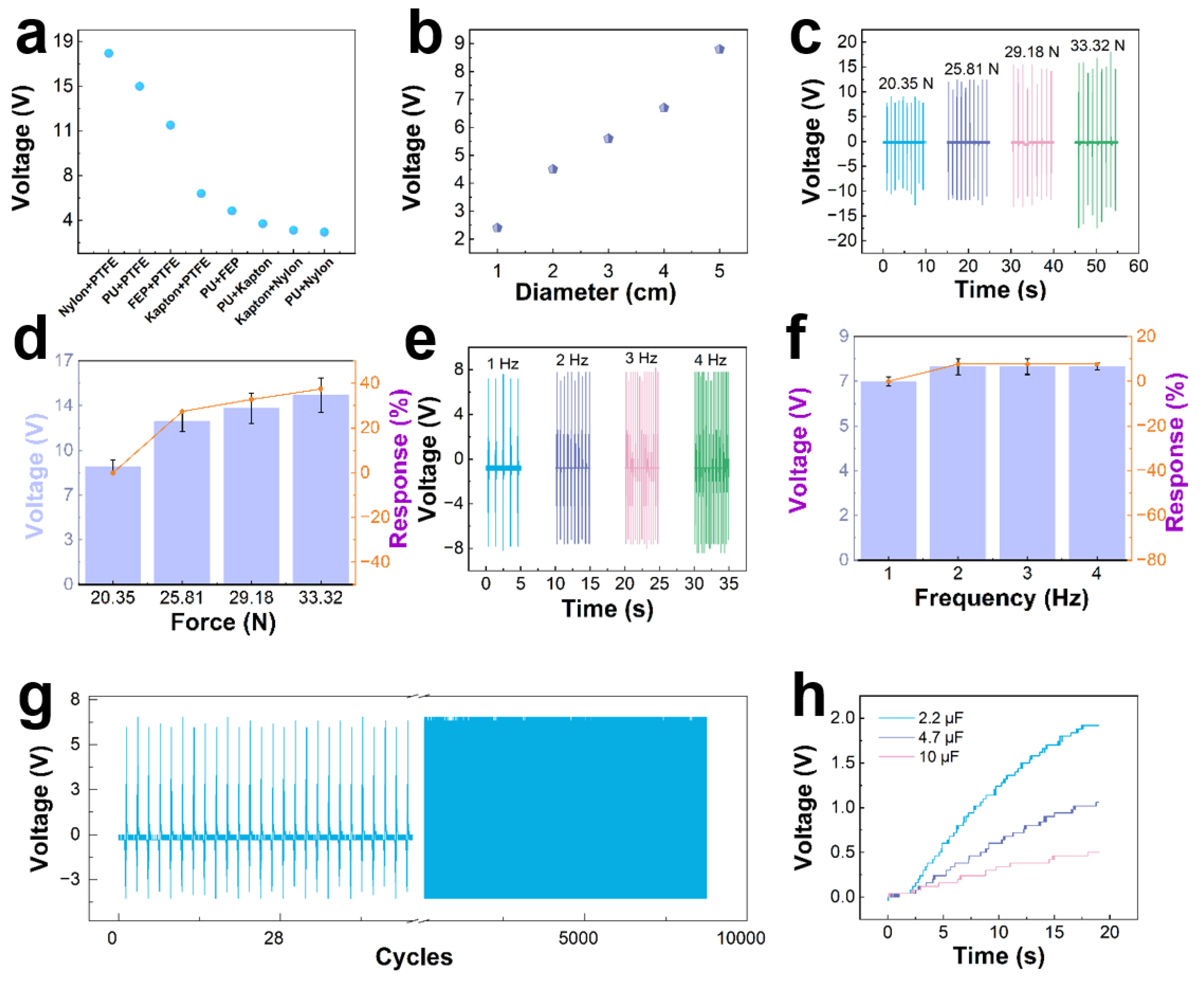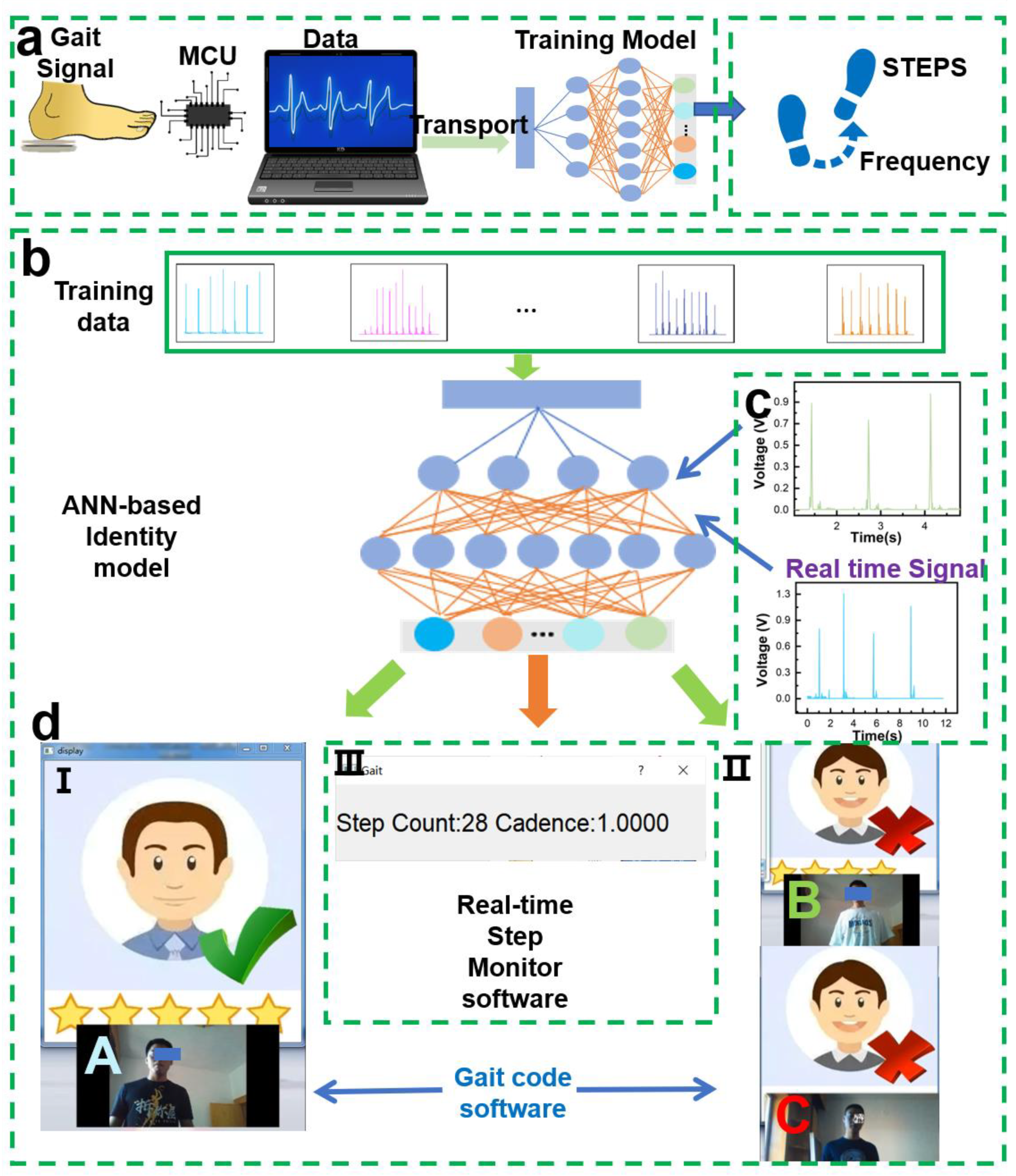A 3D Printing Triboelectric Sensor for Gait Analysis and Virtual Control Based on Human–Computer Interaction and the Internet of Things
Abstract
:1. Introduction
2. Materials and Methods
2.1. Materials
2.2. Methods
2.3. Test
3. Results
4. Conclusions
Supplementary Materials
Author Contributions
Funding
Institutional Review Board Statement
Informed Consent Statement
Data Availability Statement
Acknowledgments
Conflicts of Interest
References
- Kshetri, N. The Economics of the Fifth Generation Cellular Network. IT Prof. 2019, 21, 77–81. [Google Scholar] [CrossRef]
- Tian, X.; Lee, P.M.; Tan, Y.J.; Wu, T.L.Y.; Yao, H.C.; Zhang, M.Y.; Ho, J.S. Wireless body sensor networks based on metamaterial textiles. Nat. Electron. 2019, 2, 243–251. [Google Scholar] [CrossRef]
- Lee, S.; Shi, Q.; Lee, C. From flexible electronics technology in the era of IoT and artificial intelligence toward future implanted body sensor networks. APL Mater. 2019, 7, 031302. [Google Scholar] [CrossRef]
- Li, S.; Ni, Q.; Sun, Y.J.; Min, G.Y.; Al-Rubaye, S. Energy-Efficient Resource Allocation for Industrial Cyber-Physical IoT Systems in 5G Era. IEEE Trans. Ind. Inform. 2018, 14, 2618–2628. [Google Scholar] [CrossRef]
- Wang, Q.; Markopoulos, P.; Yu, B.; Chen, W.; Timmermans, A. Interactive wearable systems for upper body rehabilitation: A systematic review. J. Neuro. Eng. Rehabil. 2017, 14, 21. [Google Scholar] [CrossRef]
- Mukhopadhyay, C.S. Wearable sensors for human activity monitoring: A review. IEEE Sens. J. 2014, 15, 1321–1330. [Google Scholar] [CrossRef]
- Patel, S.; Park, H.; Bonato, P.; Chan, L.; Rodgers, M. A review of wearable sensors and systems with application in rehabilitation. J. Neuroeng. Rehabil. 2012, 9, 17. [Google Scholar]
- Zhang, B.S.; Tang, Y.J.; Dai, R.R.; Wang, H.Y.; Sun, X.P.; Qin, C.; Pan, Z.F.; Liang, E.J.; Mao, Y.C. Breath-based human-machine interaction system using triboelectric nanogenerator. Nano Energy 2019, 64, 7. [Google Scholar] [CrossRef]
- Lu, Z.; Zhu, Y.S.; Jia, C.J.; Zhao, T.M.; Bian, M.Y.; Jia, C.F.; Zhang, Y.Q.; Mao, Y.P. A Self-Powered Portable Flexible Sensor of Monitoring Speed Skating Techniques. Biosensors 2021, 11, 108. [Google Scholar] [CrossRef]
- Sun, F.X.; Zhu, Y.S.; Jia, C.J.; Ouyang, B.W.; Zhao, T.M.; Li, C.X.; Ba, N.; Li, X.; Chen, S.; Che, T.T.; et al. A Flexible Lightweight Triboelectric Nanogenerator for Protector and Scoring System in Taekwondo Competition Monitoring. Electronics 2022, 11, 1306. [Google Scholar] [CrossRef]
- Mao, Y.P.; Sun, F.X.; Zhu, Y.S.; Jia, C.J.; Zhao, T.M.; Huang, C.R.; Li, C.X.; Ba, N.; Che, T.T.; Chen, S. Nanogenerator-Based Wireless Intelligent Motion Correction System for Storing Mechanical Energy of Human Motion. Sustainability 2022, 14, 6944. [Google Scholar] [CrossRef]
- Mao, Y.P.; Zhu, Y.S.; Zhao, T.M.; Jia, C.J.; Wang, X.; Wang, Q. Portable Mobile Gait Monitor System Based on Triboelectric Nanogenerator for Monitoring Gait and Powering Electronics. Energies 2021, 14, 4996. [Google Scholar] [CrossRef]
- Lang, C.E.; Barth, J.; Holleran, C.L.; Konrad, J.D.; Bland, M.D. Implementation of Wearable Sensing Technology for Movement: Pushing Forward into the Routine Physical Rehabilitation Care Field. Sensors 2020, 20, 5744. [Google Scholar] [CrossRef]
- Binkley, P.F.; Frontera, W.; Standaert, D.G.; Stein, J. Predicting the potential of wearable technology—Physicians share their vision of future clinical applications of wearable technology. IEEE Eng. Med. Biol. Mag. 2003, 22, 23–27. [Google Scholar] [CrossRef]
- Maceira-Elvira, P.; Popa, T.; Schmid, A.C.; Hummel, F.C. Wearable technology in stroke rehabilitation: Towards improved diagnosis and treatment of upper-limb motor impairment. J. NeuroEng. Rehabil. 2019, 16, 18. [Google Scholar] [CrossRef]
- Zhou, H.; Li, D.X.; He, X.M.; Hui, X.D.; Guo, H.Y.; Hu, C.G.; Mu, X.J.; Wang, Z.L. Bionic Ultra-Sensitive Self-Powered Electromechanical Sensor for Muscle-Triggered Communication Application. Adv. Sci. 2021, 8, 11. [Google Scholar] [CrossRef]
- Yang, J.Y.; Liu, S.D.; Meng, Y.; Xu, W.; Liu, S.S.; Jia, L.J.; Chen, G.B.; Qin, Y.; Han, M.D.; Li, X.H. Self-Powered Tactile Sensor for Gesture Recognition Using Deep Learning Algorithms. ACS Appl. Mater. Interfaces 2022, 14, 25629–25637. [Google Scholar] [CrossRef]
- Yun, J.; Jayababu, N.; Kim, D. Self-powered transparent and flexible touchpad based on triboelectricity towards artificial intelligence. Nano Energy 2020, 78, 10. [Google Scholar] [CrossRef]
- Luo, Y.; Wang, Z.H.; Wang, J.Y.; Xiao, X.; Li, Q.; Ding, W.B.; Fu, H.Y. Triboelectric bending sensor based smart glove towards intuitive multi-dimensional human-machine interfaces. Nano Energy 2021, 89, 9. [Google Scholar] [CrossRef]
- Han, Q.K.; Jiang, Z.Y.; Kong, Y.; Chu, F.L. Prebent Membrane-Based Disk-Type Triboelectric Nanogenerator Applied to Fault Diagnosis in Rotating Machinery. IEEE-ASME Trans. Mechatron. 2022, 11. [Google Scholar] [CrossRef]
- Han, Q.K.; Jiang, Z.Y.; Xu, X.P.; Ding, Z.; Chu, F.L. Self-powered fault diagnosis of rolling bearings based on triboelectric effect. Mech. Syst. Signal Proc. 2022, 166, 14. [Google Scholar] [CrossRef]
- Zhang, Q.; Jin, T.; Cai, J.G.; Xu, L.; He, T.Y.Y.; Wang, T.H.; Tian, Y.Z.; Li, L.; Peng, Y.; Lee, C.K. Wearable Triboelectric Sensors Enabled Gait Analysis and Waist Motion Capture for IoT-Based Smart Healthcare Applications. Adv. Sci. 2022, 9, 13. [Google Scholar] [CrossRef]
- Wen, F.; Sun, Z.D.; He, T.Y.Y.; Shi, Q.F.; Zhu, M.L.; Zhang, Z.X.; Li, L.H.; Zhang, T.; Lee, C.K. Machine Learning Glove Using Self-Powered Conductive Superhydrophobic Triboelectric Textile for Gesture Recognition in VR/AR Applications. Adv. Sci. 2020, 7, 15. [Google Scholar] [CrossRef]
- Fan, F.R.; Tian, Z.Q.; Wang, Z.L. Flexible triboelectric generator! Nano Energy 2012, 1, 328–334. [Google Scholar] [CrossRef]
- Han, M.D.; Chen, X.X.; Yu, B.C.; Zhang, H.X. Coupling of Piezoelectric and Triboelectric Effects: From Theoretical Analysis to Experimental Verification. Adv. Electron. Mater. 2015, 1, 1500187. [Google Scholar] [CrossRef]
- Yu, J.B.; Hou, X.J.; Cui, M.; Zhang, S.N.; He, J.; Geng, W.P.; Mu, J.L.; Chou, X.J. Highly skin-conformal wearable tactile sensor based on piezoelectric-enhanced triboelectric nanogenerator. Nano Energy 2019, 64, 103923. [Google Scholar] [CrossRef]
- Zeeshan; Panigrahi, B.K.; Ahmed, R.; Mehmood, M.U.; Park, J.C.; Kim, Y.; Chun, W. Operation of a low-temperature differential heat engine for power generation via hybrid nanogenerators. Appl. Energy 2021, 285, 15. [Google Scholar]
- Ma, M.Y.; Zhang, Z.; Zhao, Z.N.; Liao, Q.L.; Kang, Z.; Gao, F.F.; Zhao, X.; Zhang, Y. Self-powered flexible antibacterial tactile sensor based on triboelectric-piezoelectric-pyroelectric multi-effect coupling mechanism. Nano Energy 2019, 66, 8. [Google Scholar] [CrossRef]
- Zhu, Y.B.; Yang, B.; Liu, J.Q.; Wang, X.Z.; Chen, X.; Yang, C.S. An Integrated Flexible Harvester Coupled Triboelectric and Piezoelectric Mechanisms Using PDMS/MWCNT and PVDF. J. Microelectromech. Syst. 2015, 24, 513–515. [Google Scholar] [CrossRef]
- Zhu, J.X.; Zhu, Y.L.; Wang, X.H. A Hybrid Piezoelectric and Triboelectric Nanogenerator with PVDF Nanoparticles and Leaf-Shaped Microstructure PTFE Film for Scavenging Mechanical Energy. Adv. Mater. Interfaces 2018, 5, 6. [Google Scholar] [CrossRef]
- Wu, C.S.; Liu, R.Y.; Wang, J.; Zi, Y.L.; Lin, L.; Wang, Z.L. A spring-based resonance coupling for hugely enhancing the performance of triboelectric nanogenerators for harvesting low-frequency vibration energy. Nano Energy 2017, 32, 287–293. [Google Scholar] [CrossRef]
- Haque, R.I.; Chandran, O.; Lani, S.; Briand, D. Self-powered triboelectric touch sensor made of 3D printed materials. Nano Energy 2018, 52, 54–62. [Google Scholar] [CrossRef]
- Seol, M.L.; Ivaskeviciute, R.; Ciappesoni, M.A.; Thompson, F.V.; Moon, D.I.; Kim, S.J.; Kim, S.J.; Han, J.W.; Meyyappan, M. All 3D printed energy harvester for autonomous and sustainable resource utilization. Nano Energy 2018, 52, 271–278. [Google Scholar] [CrossRef]
- Shi, Q.F.; Wang, H.; He, T.Y.Y.; Lee, C. Iop In Self-Powered Triboelectric Inertial Sensor Ball for IoT and Wearable Applications. In Proceedings of the 17th International Conference on Micro and Nanotechnology for Power Generation and Energy Conversion Applications (PowerMEMS), Kanazawa, Japan, 14–17 November 2017; Iop Publishing Ltd.: Kanazawa, Japan, 2017. [Google Scholar]
- Dong, K.; Peng, X.; Cheng, R.W.; Ning, C.A.; Jiang, Y.; Zhang, Y.H.; Wang, Z.L. Advances in High-Performance Autonomous Energy and Self-Powered Sensing Textiles with Novel 3D Fabric Structures. Adv. Mater. 2022, 34, 27. [Google Scholar] [CrossRef]
- Wajahat, M.; Kouzani, A.Z.; Khoo, S.Y.; Mahmud, M.A.P. A review on extrusion-based 3D-printed nanogenerators for energy harvesting. J. Mater. Sci. 2022, 57, 140–169. [Google Scholar] [CrossRef]
- Zhao, T.M.; Fu, Y.M.; Sun, C.X.; Zhao, X.S.; Jiao, C.X.; Du, A.; Wang, Q.; Mao, Y.P.; Liu, B.D. Wearable biosensors for real-time sweat analysis and body motion capture based on stretchable fiber-based triboelectric nanogenerators. Biosens. Bioelectron. 2022, 205, 9. [Google Scholar] [CrossRef]
- Zhu, Y.S.; Sun, F.X.; Jia, C.J.; Zhao, T.M.; Mao, Y.P. A Stretchable and Self-Healing Hybrid Nano-Generator for Human Motion Monitoring. Nanomaterials 2022, 12, 104. [Google Scholar] [CrossRef]
- Wang, Z.L. Triboelectric nanogenerators as new energy technology and self-powered sensors—Principles, problems and perspectives. Faraday Discuss. 2014, 176, 447–458. [Google Scholar] [CrossRef]
- Dickson, E.L.; DiMezza, D.; Scott, J.; Whitcomb, C.; Fitzgibbons, T.P.; McManus, D.D.; Chon, K.H. A Real-Time PPG Peak Detection Method for Accurate Determination of Heart Rate during Sinus Rhythm and Cardiac Arrhythmia. Biosensors 2022, 12, 28. [Google Scholar]





Publisher’s Note: MDPI stays neutral with regard to jurisdictional claims in published maps and institutional affiliations. |
© 2022 by the authors. Licensee MDPI, Basel, Switzerland. This article is an open access article distributed under the terms and conditions of the Creative Commons Attribution (CC BY) license (https://creativecommons.org/licenses/by/4.0/).
Share and Cite
Zhu, Y.; Sun, F.; Jia, C.; Huang, C.; Wang, K.; Li, Y.; Chou, L.; Mao, Y. A 3D Printing Triboelectric Sensor for Gait Analysis and Virtual Control Based on Human–Computer Interaction and the Internet of Things. Sustainability 2022, 14, 10875. https://doi.org/10.3390/su141710875
Zhu Y, Sun F, Jia C, Huang C, Wang K, Li Y, Chou L, Mao Y. A 3D Printing Triboelectric Sensor for Gait Analysis and Virtual Control Based on Human–Computer Interaction and the Internet of Things. Sustainability. 2022; 14(17):10875. https://doi.org/10.3390/su141710875
Chicago/Turabian StyleZhu, Yongsheng, Fengxin Sun, Changjun Jia, Chaorui Huang, Kuo Wang, Ying Li, Liping Chou, and Yupeng Mao. 2022. "A 3D Printing Triboelectric Sensor for Gait Analysis and Virtual Control Based on Human–Computer Interaction and the Internet of Things" Sustainability 14, no. 17: 10875. https://doi.org/10.3390/su141710875
APA StyleZhu, Y., Sun, F., Jia, C., Huang, C., Wang, K., Li, Y., Chou, L., & Mao, Y. (2022). A 3D Printing Triboelectric Sensor for Gait Analysis and Virtual Control Based on Human–Computer Interaction and the Internet of Things. Sustainability, 14(17), 10875. https://doi.org/10.3390/su141710875







